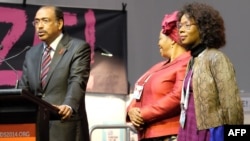Everyone at this year's AIDS conference agrees on one basic goal: eradicating the deadly virus. On the sidelines of the meeting, experts and activists have vastly different visions for how to get there.
AIDS is often called the world’s smartest disease. Once inside a host, the nine-gene retrovirus replicates with uncanny speed, yet changes tack suddenly whenever the immune system tries to challenge it.
The virus, which under a microscope looks like a little ball covered with spikes, has outwitted some of the world’s greatest scientists, who have yet to find a cure more than 30 years after the virus was first recognized. The U.N.’s AIDS organization says that in that time, AIDS has killed a staggering 39 million people worldwide.
Many paths
And so, as some 12,000 delegates -- among them, scientists, activists, and people living with HIV and AIDS -- meet this week in Melbourne, everyone seems to have a different plan for neutralizing the virus that attacks on so many fronts.
Many, like Nagat Elhadi of the Sudan Family Planning Association, have a simple wish from this conference. “Ending new infection, ending HIV new infection. All the science, all the posters, all the presentations -- come in and to work together to end new infection,” Elhadi said.
Others, like the head of UNAIDS, Michel Sidibe, have a detailed, step-by-step plan, which he outlined at the conference’s opening ceremony.
“My vision for ending AIDS looks like this: voluntary testing and treatment reaching everyone, everywhere. Each person with HIV reaching viral suppression," he said. "No one dies from AIDS, or is born with HIV. People living with HIV live with dignity, protected by laws, and free to move anywhere in the world.”
But, as many activists point out, medicine is not the only route. Society plays a powerful role in the fight against AIDS -- especially in societies where gays, lesbians, transgendered and intersex citizens are ostracized or criminalized. This conference has made special note of that issue in its declaration, calling for an end to discrimination against those who are different.
Stigmas, challenges
Abhina Aher is one such person. She was born with a male name. She now lives as a hijra -- a person who is neither fully male nor fully female -- in her native India, though she publicly identifies as female. Because hijras are ostracized, she said, they often resort to sex work to survive, which in turn leads to a huge risk of AIDS.
She said she sees a huge gap in the medical approach. If, she said, a person is so depressed that he does not care if he lives or dies, how can he be protected against HIV?
“My priority is not HIV. My priority is feminization. My priority is social support. My priority is mental health," she said. "When you design an HIV program, you cannot keep these things out of that.”
"I think the most important thing, for me, is that community doesn’t get lost in the biomedical," said researcher Kylie Johnston of the Australian Research Center in Sex, Health and Society. Because I think that they have a lot to contribute still to the fight, and also we can get sort of caught up in the science and the excitement of things like the cure and treatment as prevention, but I think we need to make sure the community is still involved.”
On the conference’s first full day, Monday, there were 87 different scheduled events -- and that does not include side events or exhibitions.
It’s a lot to think about -- especially considering that somewhere, in that enormous mental haystack, there may be that cure that everyone so desperately wants.







